The Core of the Matter
Leveraging steel-braced cores for material savings, expedited construction, and simplified trade coordination
![]() Continuing Education
Continuing Education
Use the following learning objectives to focus your study while reading this month’s Continuing Education article.
Learning Objectives - After reading this article, you will be able to:
- Explain the various reasons why structural steel is an ideal material to meet the lateral loads and wind and seismic requirements supported by the building core.
- Identify the safety and durability benefits of various long-standing steel core systems, including X-bracing, outriggers, and damping systems.
- Discuss the latest data and applications on newer systems, including steel plate sheer walls, composite systems, and pin-fuse frames.
- Describe case study applications where the different steel-braced systems were successfully applied.
The structural design for many of today’s commercial buildings is frequently focused on the building core, especially in the choice of materials used to construct it. Usually a fixed programming zone that does not obstruct things like views and mechanical equipment placement, the building core is a convenient place to satisfy the structure’s wind and seismic requirements.
“We have found that the geometry of the core aligns well with the geometry required by the lateral loads,” relates Mark P. Sarkisian, PE, SE, LEED, partner, SOM, San Francisco. “Beyond structural, the core can also provide greater resilience, particularly for egress in emergency situations.”
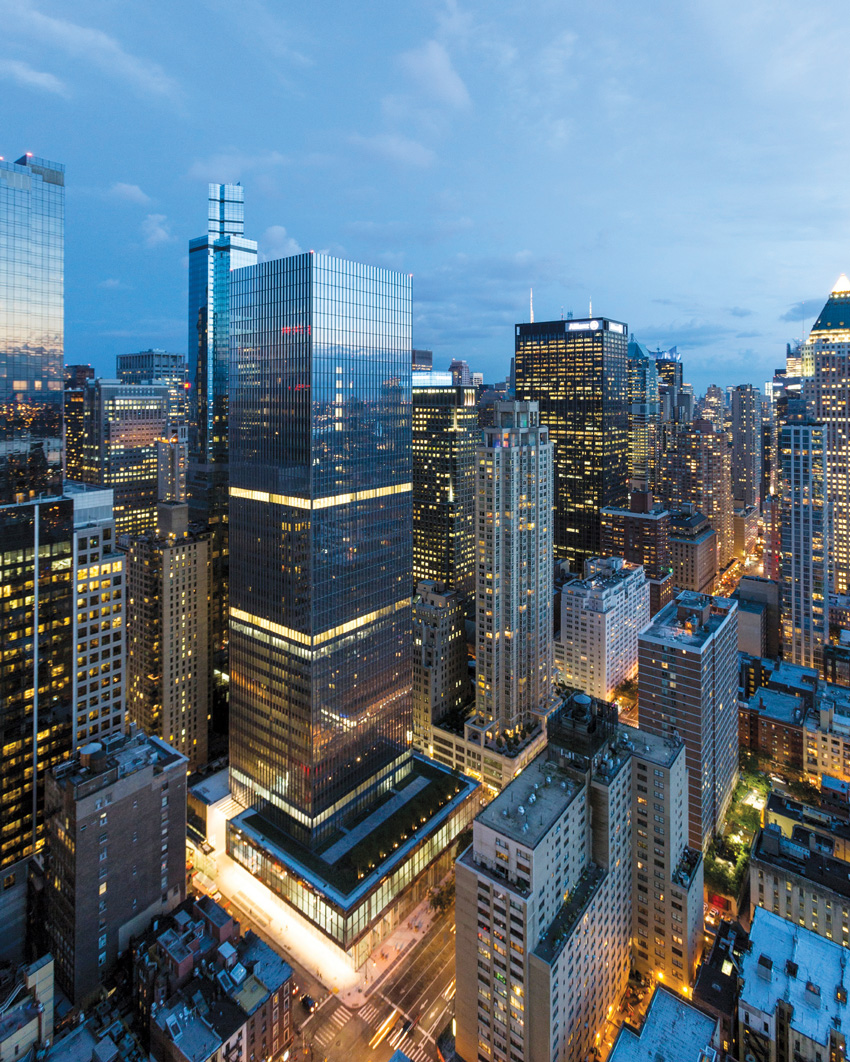
Photo courtesy of Arup/Kevin Chu
Supporting a sophisticated steel building core, Arup innovated a unique design of viscous dampers for a 40-story office tower at 250 West 55th Street in Midtown Manhattan. Attached to a series of outriggers that connect the core to the building perimeter, the dampers add additional stiffness.
While the choice of building material for the core is dependent upon a variety of factors—including the height of the building, the size of the floor plate, and site logistics—a strong argument can be made for choosing steel-braced cores over their concrete alternatives.
Offering a bit of history, Matt Jackson, PE, SE, associate, Arup, New York, relates that early high-rise towers were steel framed, generally with rigid connections between columns and beams, in order to create a stiff frame to resist the wind loads. “As the design and analysis techniques developed, and the height of towers increased, it was found that in most cases, bracing added around the core was a more efficient way to carry the wind loads, and this allowed for less steel weight, and lighter columns and beams, as compared to a moment frame system.”
“Steel-braced frames have been designed for decades with stiffness suitable for even the tallest buildings,” reports Charlie Carter, PE, SE, vice president and chief structural engineer, American Institute of Steel Construction, Chicago, citing the Windy City’s John Hancock Building and Hong Kong’s Bank of China Building as two well-known examples.
As a lighter material, a steel-braced core supports a smaller foundation and a more efficient speed of erection, thereby impacting construction schedules for the better. For example, Arup recently started work on a 16-story building in New York City. The engineers and project team chose to go with all-steel construction because the ground conditions are very challenging, so keeping the building weight to a minimum was a big driver.
“Cycle time is paramount in tall building construction, and steel framing can typically be erected much quicker than concrete can be formed and poured,” adds Tim Santi, principal, senior project manager, Walter P. Moore, Atlanta.
Attaching steel to steel is also more efficient than connecting steel to concrete, and larger floor spans from the steel core wall out to the glass facade can be achieved, explains John D. Hooper, PE, SE, senior principal/director of earthquake engineering, Magnusson Klemencic Associates (MKA), Seattle.
“Concrete systems work to tolerances that are measured in whole inches, whereas steel systems work to tolerances that are fractions of an inch,” adds AISC’s Vice President John Cross, PE.
Santi also points out that when concrete cores are used in conjunction with a steel-framed floor, embedded plates must be cast within the core, which can be a challenge for many builders to place properly. And when it comes to supporting future service penetrations into the core, in the space between braces, a steel core is much more forgiving and flexible, as compared to the expense involved in cutting or drilling into a concrete core.
Of course, another big advantage with steel-braced cores is avoiding the complexity and additional time involved in dealing with two trades—one erecting a steel structure, while the other works to form a concrete core.
“For low- and mid-rise steel buildings, steel bracing is likely to be the most economical solution, as the main structure is installed in one go, with no separate operation to form the concrete for the core,” reports Jackson.
In fact, steel-braced cores have largely been adopted as the go-to solution in New York City, where speed of erection and construction efficiencies are priorities. “NYC has become very efficient at erecting steel framed cores for steel framed building,” notes Jackson.
Although construction practices have improved over time, the safety issue of contractors placing concrete for the core above where ironworkers are erecting the steel frame still exists. In New York, this can result in project slowdowns. Modular concrete cores eliminate this problem entirely, as their erection is typically under the jurisdiction of the ironworkers. In most cases, components of these cores are manufactured off-site in custom molds, then quickly installed on-site. Because shafts are manufactured as a series of boxes, temporary structures are minimized during installation. These cores can be designed as shear walls to provide lateral stability, or as an efficient replacement for block-work or poured-in-place concrete. Working with a crane, the installers can also ensure that all components, including elevator channels and control panel recesses, are positioned precisely. According to one supplier, capping slabs are also designed with all temporary and permanent anchors cast into the concrete, ensuring safe installation of other mechanical and electrical components.
X Marks the Spot
While steel-braced core technology has advanced significantly in recent years, now providing building teams with various options, one of the most long-standing systems still in use is X-bracing.
Delivering both tension and compression on both sides, thanks to the symmetrical X-brace, the system is an efficient way to support a building’s lateral loads. While it can be applied to core, its diagonal members will obstruct the building’s views and fail to deliver sufficient stiffness to the structure, so this core approach is typically limited to lower-rise facilities with few openings.
“X-bracing is typically avoided in core framing,” confirms Eli B. Gottlieb, PE, senior principal, Thornton Tomasetti, New York City. “The X-brace layout results in gravity loads traveling through the braces in an indeterminate manner that results in additional material being required for the project. While that geometry is very efficient, for lightweight structures, it is often undesirable in the core of a tower.”
However, applying the X-bracing to the outside curtain wall—as clearly seen in the Hancock Building—is commonly done. Lending an interesting aesthetic to the exterior, keeping the views intact, and providing additional stiffness, the exterior X-brace frame has traditionally been a common choice.
At the same time, more recent steel-core innovations have opened up the range of possibilities, offering better costs, construction schedules, and more leasable square feet.
Steel Plate Shear Walls
For example, steel plate shear walls (SPSW) embrace the same concept as a braced core, only instead of a diagonal member, a steel plate is used.
“By welding a steel plate to the beams and columns, you’ve created a steel plate all made of steel. It can be as stiff as a brace, while using less materials because it’s thinner,” explains Michel Bruneau, Ph.D., PE, professor, department of civil, structural, and environmental engineering, University at Buffalo, Buffalo, New York. “It’s also thinner than the concrete walls and offers more occupiable square footage.”
With a plethora of steel plate manufacturing facilities on the market, the flat material is made in abundance. “You can prefabricate the plate and bolt it into place,” explains Sarkisian. “Stitching the columns together with the plates, even one step behind the erection of the columns, makes for a very efficiently constructed system that doesn’t require welding.”
Offering a number of advantages over conventional bracing, Gottlieb relates that SPSW are better at providing a ductile frame for seismic energy dissipation and providing a thinner profile for potentially more floor area. “For fabrication and construction, the connections are simple and clean, as the panels are rectilinear elements, ideally bolted into positions, although for higher loads, welded joints may be required.”
With thinner-plate walls, additional strength is provided from the tension-field action created by their design, according to Carter, but SPSW can also be designed as thick-plate walls, which are designed based upon plate yielding.
Offering his opinion, Mark Garland, PE, president of the Toronto-based construction management firm LCL BUILDS, explains that the performance of a steel plate shear wall is significantly enhanced if the steel plate is made thinner, and outfitted with Nelson studs, when used to function as a form for the concrete shear wall.
When furnishing SPSW, Hooper stresses the importance of making the plates as modular as possible coming from the fabrication shop. This includes minimizing or even eliminating the need for complete joint penetration welds so that these connections are minimized as much as possible on-site. “Otherwise, these welds take a lot of time and are difficult to do up in the air.”
If building teams are looking for guidance, AISC’s Design Guide 20: Steel Plate Shear Walls, authored by Bruneau and Rafael Sabelli, SE, director of seismic design, Walter P. Moore, San Francisco, is a good resource. “Anything you wish to know about SPSW is pretty much in there, including lots of research,” says Bruneau.
In addition, AISC’s Seismic Provisions for Structural Steel Buildings offers guidelines such as standard thickness for plates. “We go beyond what the specification requires, as we’re dealing with a lot of high seismic projects in California,” relates Hooper.
MKA uses the latest data on SPSW performance to help inform their designs, taking advantage of test results conducted by universities like Purdue and State University of New York Buffalo State.
While AISC is in the process of updating its seismic provisions document, that guideline won’t be available until 2017. In the meantime, Bruneau’s textbook, Ductile Design of Steel Structures, is a helpful reference with a lot of up-to-date information on SPSW, as well as other steel-braced core options.
China's Jinta Tower
For the Jinta Tower in Tianjin, China, described as the world’s tallest steel shear plate wall building at 75 stories, the building team, led by SOM, evaluated a number of options for the core before selecting a SPSW system.
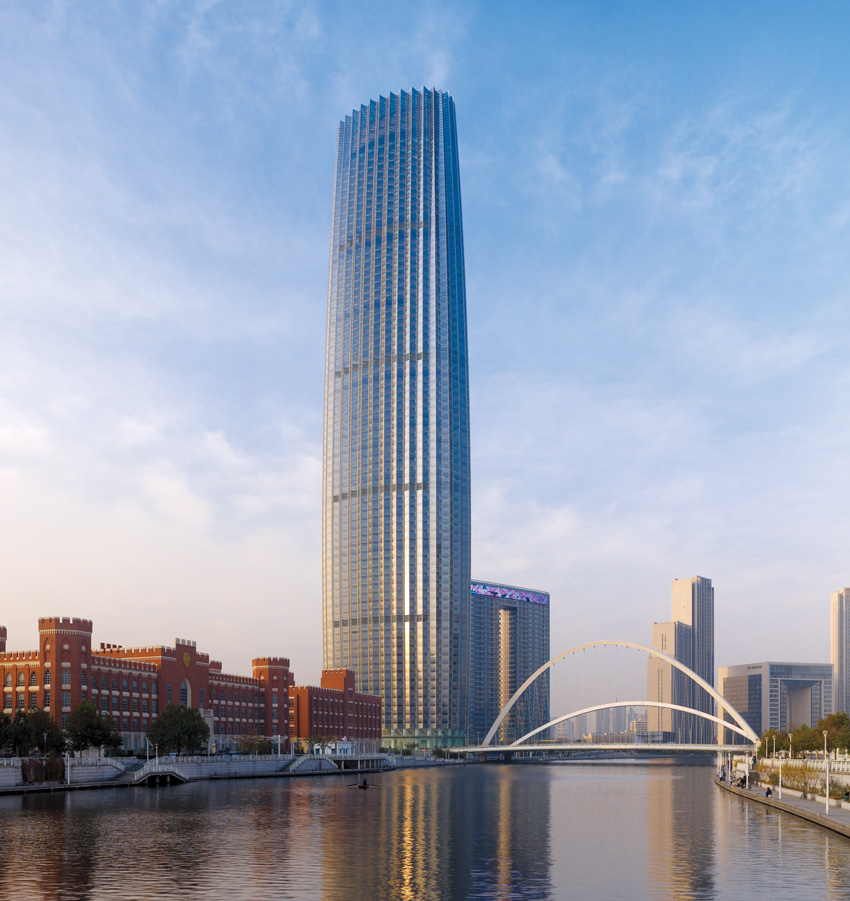
Photo courtesy of SOM
As the world’s tallest steel shear wall building, the 75-story Jinta Tower in Tianjin, China, utilizes perimeter and core ductile moment-resisting frames and outrigger and belt trusses to withstand seismic and wind forces.
In particular, an all-concrete dual system with perimeter moment-resisting frames and core shear walls was ruled out because the large shear wall and column sizes would have decreased the rentable area, and consequently the project’s financial viability.
Composite concrete and steel plate shear walls were also considered, but ultimately, there was insufficient research and testing data—addressing specific features of the project—to satisfy the authorities. Meanwhile, dual steel systems with braced cores would have required as much as 20 percent to 25 percent more steel. So ultimately, SPSW proved to be the most appropriate choice.
For the very slender, uniquely shaped skyscraper, with an overall aspect ratio of close to 1:8, SPSW also delivered an efficient lateral system capable of resisting significant wind and seismic lateral loads, while keeping wind-induced lateral drifts and oscillations under acceptable limits.
Altogether, the main lateral force-resisting system consists of a frame-shear wall system with perimeter and core ductile moment-resisting frames and core SPSW linked together with outrigger and belt trusses. As for the ductile moment-resisting frames, in an American Institute of Physics (AIP) Seismic Engineering Conference white paper, “Steel Plate Shear Walls: Efficient Structural Solution for Slender High-Rise in China,” authored by Sarkisian and his SOM colleagues, the frames are described as concrete filled steel pipe composite (CFT) columns and structural steel wide-flange beams. Similarly, the SPSW are CFT columns and structural steel wide-flange beams in-filled with structural steel plates.
To ensure that the perimeter columns resist overturning, outrigger trusses are placed in the short direction of the tower plan. Meanwhile, belt trusses at the outrigger levels work to better distribute the axial loads resulting from outrigger action among the perimeter columns. Four sets of outrigger and belt trusses are positioned at the mechanical levels, and strengthened diaphragm slabs are used at the outrigger levels.
“The columns are circular, and the framing is built up with plate running two-thirds the height of the building and then changes to a braced frame,” relates Sarkisian.
As explained in the AIP conference white paper, “The building frames are designed to carry gravity loads while neglecting the contribution of the SPSW plates, which ensures that the building frames have sufficient capacity to support the gravity loads during seismic events when the plates could experience buckling due to the development of the tension-field action.”
The SPSW plates were sized to respond elastically without tension-field action or buckling from the region’s frequent earthquake loads and wind loads. In the event of a moderate earthquake, tension-field action is expected to be the primary lateral load resisting mechanism in the SPSW plates.
LA Live Project
Delivering more programming space than thick concrete walls were capable of doing, SPSW were selected for the core of the LA Live project in Los Angeles to resist lateral loads, add stiffness, support seismic needs, and decrease gravity loads. Combining hotel rooms and condos, the Gensler-designed dual towers stand 26 stories and 29 stories, respectively.

Photo courtesy of Nabih Youssef Associates
Offering more programming space than concrete, Nabih Youssef Associates specified steel plate shear walls to resist lateral loads, add stiffness, support seismic needs, and decrease gravity loads for the LA Live project in Los Angeles.
Specified by structural engineer Nabih Youssef Associates, unstiffened thin steel plates—ranging from 1/4-inch to 3/8-inch thick—inside fully welded unreinforced flange-welded (WUF-W) connected moment frames act as boundary members. As described in an AISC case study, the infill plates buckle in shear and form a diagonal tension field, which resists lateral loads and delivers a high level of post-buckling ductility.

Image courtesy of Nabih Youssef Associates
The unstiffened thin steel plates inside fully welded WUF-W moment frames are between 3/8-inch and 1/4-inch thick and act as boundary members for the LA tower. The infill plates buckle in shear and form a diagonal tension field, which acts to resist lateral loads and offers a high level of post-buckling ductility.
In absence of a centralized core of walls and due to the fact that the 26-story tower floor plan is designed as a “T” shape, the steel plates work to “tune” the stiffness of the separate wings.
Further limiting building drift, outriggers designed at mid-height and the roof level work to reduce the aspect ratio from 20:1 to 10:1. Buckling restrained braces (BRBs), some as large as 2,200 kips, are applied as fuse elements to control the maximum forces the outrigger trusses are capable of imposing upon the surrounding elements. Although this is no longer the case, at the time when the towers were designed, the BRBs bore the distinction of being the largest applied global system to be tested.
In addition, the 3/8-inch-thick steel plate shear walls add significantly more usable square footage than 3-foot-thick concrete core walls are capable of delivering.
Rigging Up with Outriggers
The taller a lateral system is, the harder it is to control lateral movement in a building, so outriggers are a good way to boost the stiffness and strength of the core.
“Outrigger systems can provide a lot of additional stiffness to a core by effectively mobilizing the perimeter columns, and hence the overall width of the building, to resist the overturning forces from the wind,” adds Jackson. “Due to this increase in width that they can mobilize, less steel is needed to provide the same stiffness.”Defined as braces connecting the outside of a building structure to the inside, outriggers work to keep a building’s aspect ratio to between 12:1 or 13:1, to prevent the building from moving too much.

Image courtesy of Magnusson Klemencic Associates
MKA’s engineering design for One Rincon Hill’s high-rise residential towers in San Francisco illustrates how the outrigger sits outside the core to lend added stiffness and support to the building structure.
Comparing an outrigger to the process of people losing their balance and reaching out to brace themselves, Cross explains that the outrigger leans on the gravity framing to help secure the building.
“The outrigger locks the core for added stability and resistance,” explains Sarkisian. “Typically designed at the mechanical level where it won’t impact usable square footage, the outrigger is a very efficient way to resist loads.” Outrigger-braced cores are a popular choice for taller buildings because they usually only impact every 10 to 15 stories of floors. With the exception of super-tall buildings with belt trusses, an outrigger-braced core system leaves the building perimeter as free of structure as possible, thereby maximizing unobstructed views, says Santi. “I would estimate that more than half of all outrigger systems around the world are constructed out of steel trusses, and the connections of steel outrigger trusses to a steel-framed core are far simpler and less time consuming than connecting steel outrigger trusses to a concrete core.”
By linking the core to the perimeter, outriggers enable the core to be engaged to the full dimension of the building. But to ensure optimal performance, Gottlieb stresses the importance of positioning the outriggers vertically and ensuring that the right number of outriggers are specified and installed.
While these systems can be very beneficial, the big issue is that a lot of lease space is negatively impacted by their presence. The design typically occupies two stories in height and connects the core to the perimeter columns. This is often combined with a perimeter “belt” truss that ties all the perimeter columns together, explains Jackson. The upshot is that constraints are placed on the floor layout, which is why the mechanical level is the best place to situate them. Because the most efficient location for an outrigger is typically about one-third of the way up the building, it is best to place the mechanical equipment at this location as well. However, for very tall towers, several levels of outriggers may be required, so outrigger placement may be a compromise between the optimum location for both structural and mechanical needs.
Santi also points out that outrigger systems are not inexpensive and can significantly slow down construction due to their uniqueness and complexity. This being the case, it’s important to conduct efficiency studies to minimize the size and number of outrigger levels.
“Another important factor when considering outrigger systems is the timing of connection of the outrigger to the core,” he adds. “The timing of connection must be managed properly, and often delayed until several more floors are constructed above the outrigger, to prevent unwanted gravity load transfer between the core and the perimeter columns through the outriggers.”
As an alternative to outriggers, a tube-in-tube system is a tube that runs around the perimeter of a building, essentially mobilizing the perimeter framing of the building to supplement the stiffness of the core. “A perimeter moment frame makes the building perimeter resist lateral loads, and can eliminate the need for outriggers or additional bracing that can compromise the space within the building,” explains Jackson.
Forming a square shape in elevation, it’s an efficient system that has been used in several prominent buildings. Such a perimeter tube system is in place at Chicago’s Sears Tower, a modified tube system frames 5 Times Square in Manhattan, and a perimeter lateral system with a gravity-only system for the tower core was designed for 7 Times Square.
“A tube system will generally require more expensive moment connections between the beams and columns, which can add to cost but may liberate more leasable space compared to an outrigger system,” explains Jackson.
The Arup engineer also points out that a tube system typically requires relatively closely spaced columns to work efficiently, so it should ideally be studied early in the design process so that it’s integrated into the overall design.
At the same time, Santi notes that this closely spaced column requirement, and subsequent obstructed views, is generally not a plus for owners and architects.
Damping Systems
In cases where the core is not stiff enough, another option is adding dampers to control building movement.
“For mid-rise towers, the use of supplemental damping may make steel-braced cores or all steel towers more attractive due to the lower material requirements and the improved single trade construction,” reports Gottlieb.
“Effective damping systems, such as tuned mass dampers, liquid column dampers, or distributed viscoelastic dampers, have made lightweight, taller towers with steel cores more viable,” he continues. “Supplemental damping systems are often explored as ways to improve the performance of steel core buildings without having to add material.”
Acting to reduce the amount of required structural framing, dampers are also advantageous for improving predicted accelerations that the occupants will experience in the event of abnormal wind conditions or a seismic occurrence.
Mass dampers are commonly used to mitigate wind events, although Jackson says that viscous dampers, which are also appropriate for seismic regions, have been specified and offer the benefit of achieving the same damping effect with less weight and space.
Case in point, at the 40-story office tower at 250 West 55th Street in New York City—designed by architect SOM and structural engineer Arup—viscous dampers were found to be the most effective way to handle the building’s wind loads.

Image courtesy of Arup
Thanks to a novel arrangement of viscous dampers, incorporated with a series of outriggers connecting the core to the building perimeter, only seven dampers were required, thereby reducing the overall system cost to less than half of a conventional tuned mass damper system.
In this particular case, wind tunnel testing conducted at the end of the schematic design found that the loading on the building from the wind was less than that required by the code. Furthermore, as explained by Jackson and his colleagues in an American Society of Civil Engineers 2014 Structures Congress white paper, accelerations that occupants would experience at the top of the tower were predicted to be higher than desirable, according to most guidelines. Contributing to this situation was the fact the lower floors were predicted to experience significant shielding from other buildings, while the higher floors were subject to buffeting from the wind interacting with surrounding tall buildings.
Because the actual wind loads were lower than those the building was designed to handle, this potentially allowed for some steel tonnage to be removed. However, there was concern that the reduced steel would further increase accelerations. So in order to capitalize on the cost-effective possibility of reducing the overall amount of steel, various damping solutions were investigated.
For starters, mass dampers and tuned liquid column dampers were considered, but this would have required significant rearranging of the mechanical room—the ideal location for the dampers—that was originally designed to be at the top of the tower.
Fortunately, the design team came up with a novel arrangement of viscous dampers, which involved incorporating the dampers into a series of outriggers connecting the core to the building perimeter, explains Jackson. As a result of arranging the dampers into this outrigger configuration—and damping the dominant flexural deformation rather than shear deformation—only seven dampers were ultimately required.
Jackson and his colleagues also note that the damper design for this project was quite different from those normally used in seismic projects in that damping had to be provided at very small displacements, while constantly cycling whenever there are high winds. In order to address this requirement and to deliver a long service life free of maintenance, they specified dampers without conventional seals.
Another design challenge was the fact that the viscous damping system had to be analyzed as a part of the overall structure as opposed to a separate bolt-on system, such as is the case with a tuned mass damper.
As delineated in an October 2013 AISC Modern Steel Construction article on the project, the design team was able to use conventional analysis processes for the vast majority of the design, as most of the steelwork was not controlled by the damper forces. But for the analysis and optimization of the damping systems themselves, the team used MSC-Nastran.
“When you introduce a viscous damper in place of a steel brace, for example, the way it behaves is not captured correctly by a normal analysis, so different software is needed to analyze these damping elements,” explains Jackson.
Ultimately, despite all that was involved in specifying the viscous dampers, the overall system cost was less than half the cost of a conventional tuned mass damper system.
Steel Concrete Composite Systems
Capitalizing on the strength and stiffness of concrete, together with steel’s slender, lightweight profile, newer steel concrete composite core systems are providing designers with yet another viable option.
One developing version of this composite mix is the steel-braced concrete shear core, designed by Garland’s firm LBL BUILDS. The approach utilizes redundant structural steel columns inside concrete shear walls, which enables the structural steel and rebar curtains to be erected concurrently and in advance of the concrete wall placements.
“With a conventionally constructed concrete shear core, the construction team is challenged to erect two completely separate buildings: the advanced concrete core and the structural steel building frame,” explains Garland. “This discontinuity is time consuming, costly, and suffers from interruptions, mobilization, and demobilizations of various trade activities because the two different building erections proceed at significantly different paces.”
On the contrary, “the most significant advantage of the steel-braced concrete shear core is that the concrete work follows the structural steel erection, rather than the other way around,” says Garland. As a result, this approach is capable of delivering approximately 5 percent in hard cost savings, as compared to a conventional concrete system.

Image courtesy of LBL BUILDS
In comparing a steel-braced concrete shear core to a conventional concrete core, erection time proceeds at an average of two stories per day faster. As illustrated here, the structural steel of this mid-rise tower has been topped out in the time it takes to build a 10-story concrete core.
As described by Garland, the system offers the following benefits from a construction perspective:
- It’s easier to raise the concrete shear core out of the ground, and no complicated rebuilding of the concrete forming systems, as the story height changes, is necessary.
- The concrete work follows the structural steel, as opposed to the steel erection waiting for the concrete core to be constructed.
- The steel-braced core does not require separate construction facilities, as the separate man/material hoist and separate stair towers for the core construction are eliminated.
- Structural tolerances inside the concrete core are easier to manage.
- The structural steel building erection can continue uninterrupted, as there is no need to wait for the core.
- Elaborate climbing or jump-style concrete core forming systems are not required.
- For a conventional 20-story office building, the steel-braced concrete shear core can reduce the construction time by two days per story. In taller buildings, even more time is saved.
- The permanent building elevators can be installed and brought online before a comparable conventional concrete shear core has topped out.
U.S. Federal Courthouse in Seattle
Developing its own take on a composite structural system, MKA designed a unique system that combines steel plate and concrete-filled pipe to deliver gravity, wind, and seismic protection for the 23-story U.S. Federal Courthouse in Seattle.
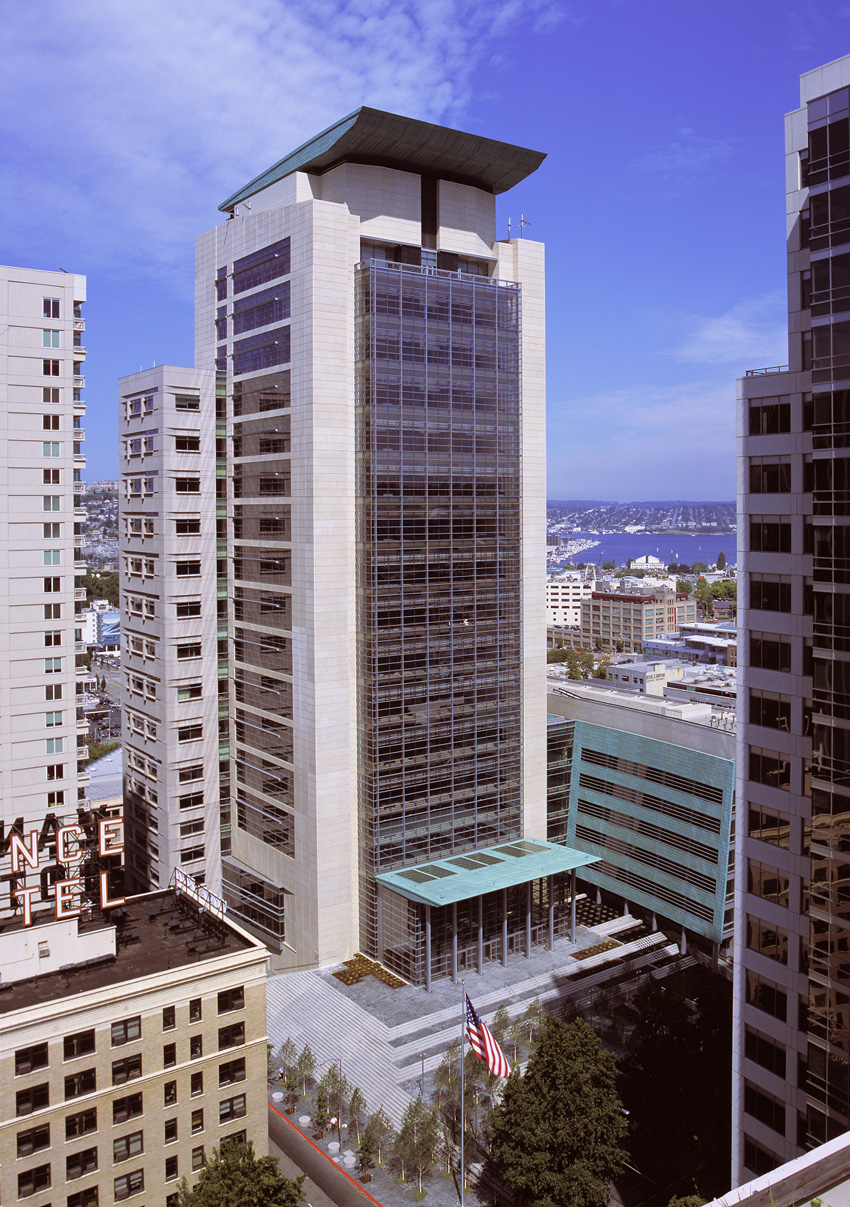
Photo courtesy of Magnusson Klemencic Associates/Frank Ooms
A unique steel plate and concrete-filled pipe composite system deliver a high level of seismic and wind protection at for the 23-story U.S. Federal Courthouse in Seattle.
The combined steel-braced frame with steel wide-flange beams and columns, steel plate wall panel, and concrete-filled steel pipe columns eliminate the need for a full perimeter backup moment frame, thereby delivering open, flexible floor plates. On the building’s north and south side, 1-inch-thick steel plates are welded between the 5-foot-diameter pipe columns, while conventional steel framing was specified for the other elevations. Meanwhile, the core runs through the majority of the building height.
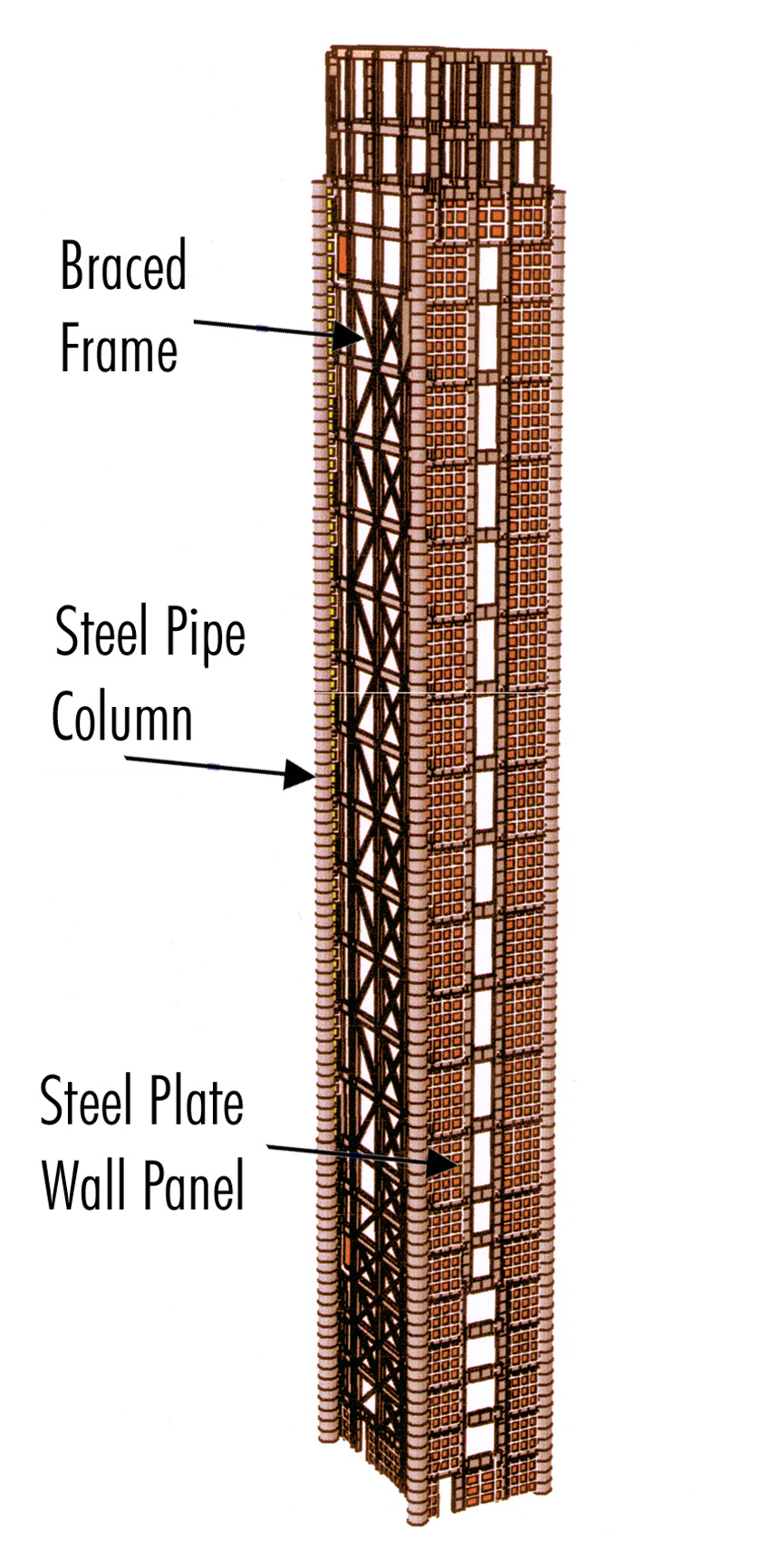
Photo courtesy of MKA
A steel-braced frame, concrete-filled steel pipe columns, and steel plate wall panel make up the high-performing composite system that meets the U.S. General Services Administration’s strict structural requirements.
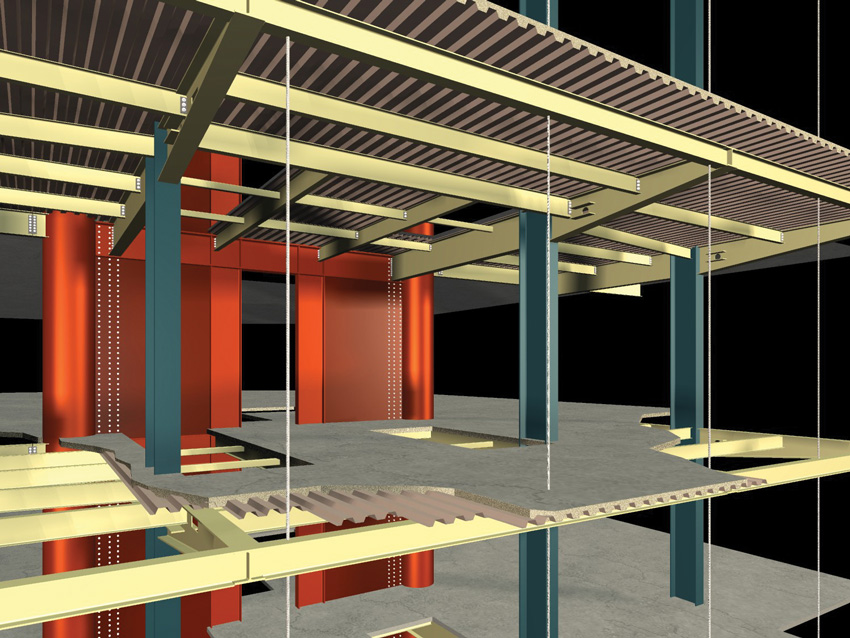
Image courtesy of Magnusson Klemencic Associates
This Seattle U.S. Federal Courthouse rendering depicts the connection of cantilevered steel framing with steel cables running through the floors to minimize floor vibration.
The unique structural core design provides resistance for more than two-thirds the weight of the building and all of the wind and earthquake forces.
Capitalizing on both concrete’s compressive strength and structural steel’s seismic energy-absorbing properties, the steel plates are designed to buckle and bend in the event of an earthquake, while protecting the surrounding framework holding up the building. Furthermore, through each seismic cycle for buckling and bending, the design resists seismic forces even further.
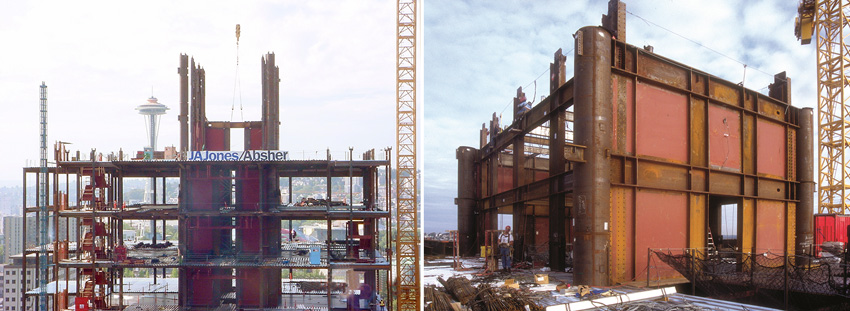
Photos courtesy of Magnusson Klemencic Associates
The floors and steel plate shear walls are seen as the core is being constructed at the Seattle courthouse.
“With the steel plate shear wall, the courthouse’s robustness requirements were met with a much thinner wall thickness,” explains Hooper.
In fact, the U.S. General Services Administration funded independent testing on the new structural system and discovered that it exceeded performance of all steel structural methods currently in the building code. As a result, the GSA has adopted the composite system as a model for future secure government building construction.
Additional benefits delivered by the composite system include:
- The building’s primary system and the backup system are co-planar, reducing cost and providing better earthquake performance.
- Because the core is lighter than an all-concrete core, overall earthquake demands on the lateral system are reduced.
- The system more easily facilitates larger openings through the core, offering increased layout flexibility.
- The composite pipe columns use less steel than comparable all-steel sections and serve as erection columns, formwork, vertical reinforcement, shear reinforcement, and seismic-confinement reinforcement, further reducing cost and improving performance through “perfect spiral reinforcing.”
- The 10,000-psi high-strength concrete developed for use in the pipe columns further enhances economics and performance, providing greater stiffness and lower net cost than conventional concrete.
- The steel plate shear wall panels provide the greatest energy absorption of any primary structural system during a major seismic event, while simultaneously offering excellent lateral stiffness for smaller events and wind.
- A single trade can erect the building, and there is no need for labor-intensive moment-frame welds at the exterior, as the high-strength concrete is pumped from the bottom of the pipe columns after steel erection.
Made mostly from steel, the core system is much lighter than all-concrete systems, delivering estimated savings of 10 percent in foundation costs.
Taken together, the noninvasive structural core supports column-free courtrooms with 20-foot-high ceilings and a large, soaring all-glass lobby with a reflecting pool.
Pin-Fuse Frame
Another interesting development for strengthening the core is the pin-fuse frame, innovated by SOM. The patented friction-fuse system essentially combines the stiffness and efficiency of braced frames with the ductile behavior of moment frames with beam-columns and brace “fused” joints that slip in friction at preset force levels.
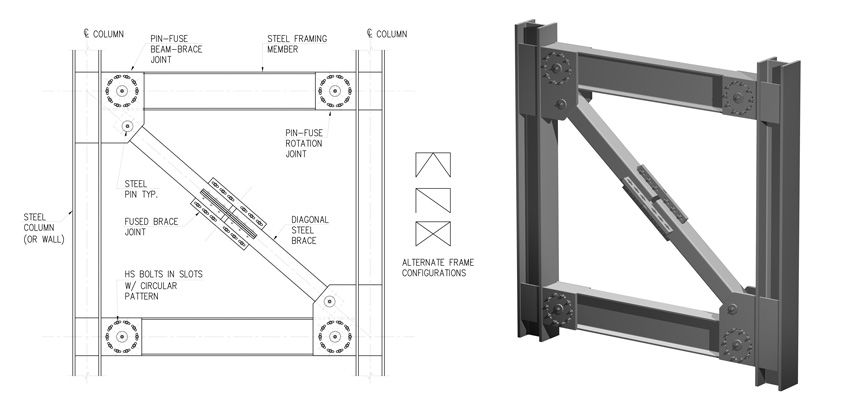
Images courtesy of SOM
Contributing to the growing selection of steel-braced core innovations, SOM’s pin-fuse frame is a patented friction-fuse system, which combines the stiffness and efficiency of braced frames with the ductile behavior of moment frames. Beam-columns and brace “fused” joints slip in response to friction at preset force levels that work to strengthen the building core.
Connected with bolts containing a friction surface, Sarkisian explains that in response to a seismic event, the brace starts to slide, thereby creating heat and slowing down the momentum. “We think the technology has a lot of promise, particularly in earthquake-prone regions,” he says. We’re finding huge interest, driven by recent earthquakes and people’s interest in getting back into their [undamaged] buildings after an earthquake.”
The system essentially achieves energy dissipation without yielding primary structural elements to drift levels of at least 4 percent, thereby reducing post-earthquake repair costs. While the technology’s friction-slipping characteristics work to dissipate energy in major seismic events, they remaining fixed in wind and minor seismic events.
Furthermore, the pin-fuse frame locks elastic strain energy into the structure that can be recovered to re-center the building following a major seismic event.
As reported in the “Pin-Fuse Frame: Full Scale Tests” white paper prepared for the Structural Engineers Association of California and authored by Sarkisian—along with a couple of his SOM colleagues and researchers from the University of California, San Diego— analysis studies indicate that the system behaved satisfactorily under design ground motions, and in several performance aspects, it was superior to conventional reduced beam section moment connections.
Choosing Steel
While steel-braced cores continue to gain traction, Santi points out that steel framing requires more skilled labor, and in some cases, that expertise is simply not available in many parts of the world where tall buildings are being built.
That said, he predicts that “as regions are further developed and as they become more sophisticated, steel construction will probably become more and more viable.” Furthermore, as an alternative to the very high carbon emissions associated with cement production, Santi further anticipates that the pendulum will swing back toward predominantly steel-framed tall buildings.
At the same time, while steel-braced cores may be ideal for many buildings, in some cases, a steel perimeter system might make more sense, or perhaps a planar system between the core and the perimeter.
Regardless, Jackson remarks that steel remains the material of choice for office and retail spaces that prefer long spans and the easier ability to make future modifications and openings.
Sarkisian adds that buildings simply adhering to the building code will likely experience damage requiring major replacement in the event of an earthquake. “The use of steel really helps with both performance and long-term cost benefits. I think the popularity of the material with increase over time.”
Ultimately, Hooper remarks that he is very supportive of architects becoming more aware of the different structural options that are available. “The more architects know, the easier it is for us, as structural engineers, to explain things to them and discuss these options.”
Barbara Horwitz-Bennett is a trade press journalist who has covered the design and building industry for the past 17 years. She contributes regularly to a number of leading architectural publications.

|
The Steel Institute of New York is a not-for-profit association created to advance the interests of the steel construction industry by helping architects, engineers, developers, and construction managers develop engineering solutions using structural steel construction. www.siny.org |
